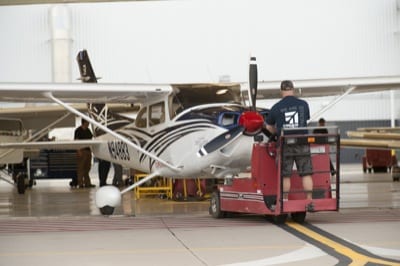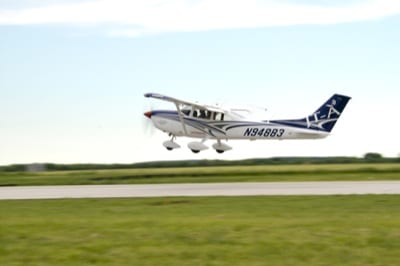WICHITA, Kan. — The first production flight of Cessna’s Turbo Skylane 182 JT-A took place May 21 at the company’s facility in Independence, Kan. The aircraft is powered by a piston engine specifically designed to run on Jet-A fuel.
“The Turbo Skylane JT-A performed just as expected,” said Cessna senior test pilot Dale Bleakney. “The weather conditions were fantastic, and we took the turbo 182 up for what turned out to be a very normal first flight. We flew for 2.3 hours, achieved a flight level of 8,000 feet, and attained a true air speed of 158 kts. We brought it in and did some takeoffs and landings, and everything went as expected.”
 “The JT-A is the result of years or hard work put in by our engineering, research, and manufacturing teams,” said Jeff Umscheid, business leader for the Cessna 172, 182 and 206 model aircraft. “This is groundbreaking in that it is the first aircraft powered by a diesel engine specifically designed for aviation. Operators will find many surprising advantages with the JT-A, and pilots will enjoy the lower workload. Add to this the benefit of being able to fuel it with a much cheaper, more available fuel anywhere in the world and it’s not difficult to see why the JT-A is in such demand.”
“The JT-A is the result of years or hard work put in by our engineering, research, and manufacturing teams,” said Jeff Umscheid, business leader for the Cessna 172, 182 and 206 model aircraft. “This is groundbreaking in that it is the first aircraft powered by a diesel engine specifically designed for aviation. Operators will find many surprising advantages with the JT-A, and pilots will enjoy the lower workload. Add to this the benefit of being able to fuel it with a much cheaper, more available fuel anywhere in the world and it’s not difficult to see why the JT-A is in such demand.”
Industry observers have noted a looming fuel issue for general aviation in most parts of the world. Avgas is typically used to fuel most single engine aircraft, but the fuel is becoming scarce, expensive, and even unavailable in many parts of the world. With the advent of a single engine craft designed to run on the much more common Jet-A fuel, operators can now access many more parts of the world without worrying about the unpredictable availability and price of increasingly scarce avgas, Cessna officials noted.
 The Safran-made SMA engine in the Turbo Skylane JT-A is engineered specifically for aviation. The 227-hp engine burns 11 gallons per hour of the typically lower-cost Jet-A fuel at the estimated maximum cruise speed of 156 knots. Flight at the maximum cruise speed demonstrates greater fuel efficiency, and it is expected to burn approximately 30% to 40% less fuel than comparable avgas engines, Cessna officials said.
The Safran-made SMA engine in the Turbo Skylane JT-A is engineered specifically for aviation. The 227-hp engine burns 11 gallons per hour of the typically lower-cost Jet-A fuel at the estimated maximum cruise speed of 156 knots. Flight at the maximum cruise speed demonstrates greater fuel efficiency, and it is expected to burn approximately 30% to 40% less fuel than comparable avgas engines, Cessna officials said.
The Turbo Skylane JT-A has a seating capacity for four and an estimated range at max cruise speed of 1,025 nautical miles. The certified ceiling will be 20,000 feet. The plane features the Garmin G1000 avionics and engine diagnostics are shown on the primary and multi-function flight displays. Fuel capacity is 87 useful gallons, with an estimated useful load of 1,018 pounds.
For more information: Cessna.com

Cessna should make the engine installation available as a retrofit on older 182’s. The new airplane at $500,000 is an option for fleet operators only, and even they would have to fly a lot to to make financial sense even with the 40% less fuel use. Trading in the gas engine at replacement time, would drastically improve the cost/benefit equation, making this engine a very interesting option.
SMA already has an STC for putting this engine in certain older 182 models – since 2006. That’s why this is a relatively low risk move for Cessna.
John I understand. I was thinking of the convenience and comfort factor of the O.E.M. doing the change. Beechcraft did this with the 18, Volpar tri-gear mod. Their are, I am sure many other examples, that is the only one I have experience with that was converted/installed at the factory. I also once maintained a Piper Navajo “Panther” it was a months long conversion at Colemill enterprise. The customer got back essentially a new airplane at a fraction of the cost. This is fairly common with cabin-class and the Cessna Diesel could make it work at the lighter end of the spectrum.